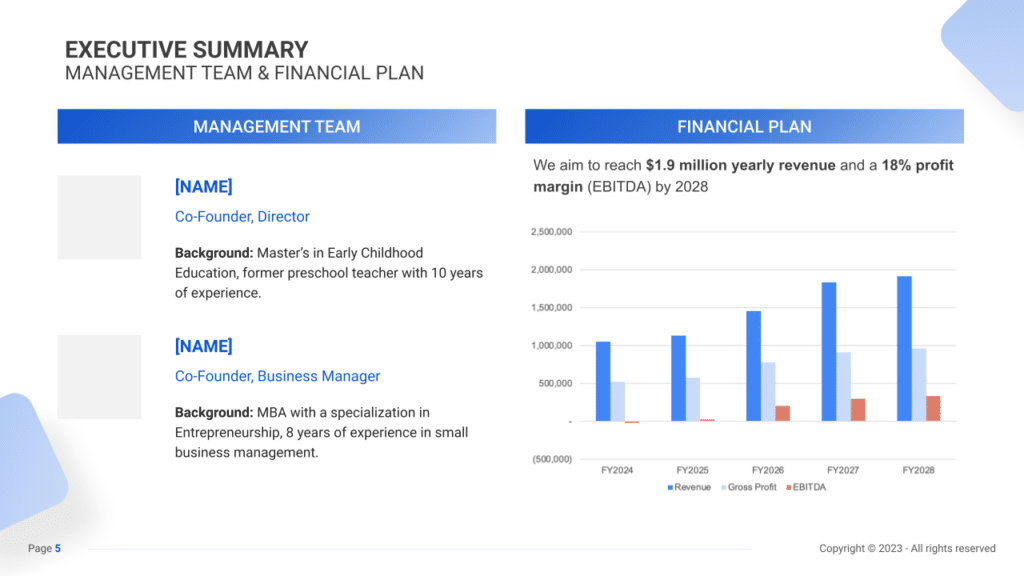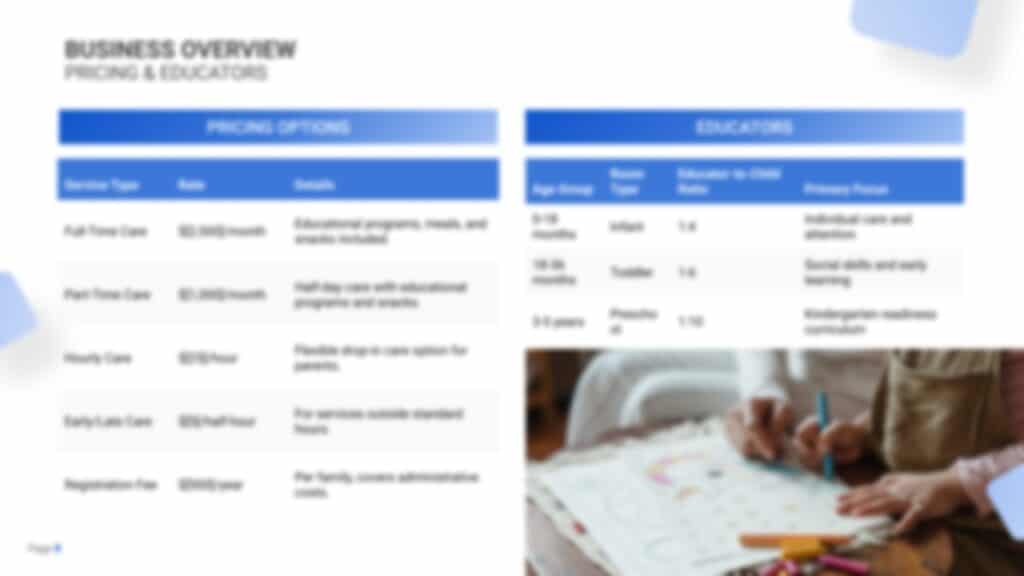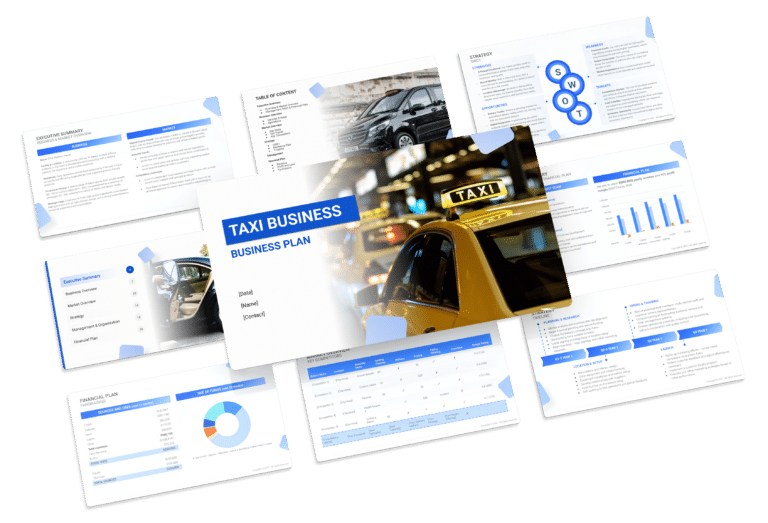Daycare Business Plan Template & PDF Example

Creating a comprehensive business plan is crucial for launching and running a successful daycare. This plan serves as your roadmap, detailing your vision, operational strategies, and financial plan. It helps establish your daycare’s identity, navigate the competitive market, and secure funding for growth.
This article not only breaks down the critical components of a daycare business plan, but also provides an example of a business plan to help you craft your own.
Whether you’re an experienced entrepreneur or new to the service industry, this guide, complete with a business plan example, lays the groundwork for turning your daycare business concept into reality. Let’s dive in!
The Plan
Our daycare business plan is thoughtfully developed to encompass all crucial aspects required for an in-depth strategic plan. It outlines our facility’s operations, marketing strategies, market dynamics, competitors, management team, and financial projections.
- Executive Summary: Offers an overview of your Daycare’s business concept, including the innovative learning environment, market analysis, management team, and financial strategy.
- Business Overview: Provides detailed information on what your Daycare offers and its operational model:
- Building & Location: Describes the Daycare’s modern, child-friendly design, its central location, and amenities such as indoor and outdoor play areas, sensory rooms, and nap zones.
- Pricing & Educators: Lists the services provided by your daycare, including full-time and part-time care options, the educator-to-child ratio, and pricing structure.
- Market Overview: Examines the childcare industry landscape, identifies competitors, and how your daycare stands out:
- Key Stats: Shares industry size, growth trends, and relevant statistics for the Daycare market.
- Key Trends: Highlights recent trends affecting the childcare sector, such as the increasing demand for early childhood education programs and technological integration.
- Key Competitors: Analyzes main competitors nearby and how your daycare differs from them, focusing on aspects like curriculum quality and additional services.
- Strategy: Outlines how the daycare intends to achieve growth and attract clients:
- SWOT: Strengths, weaknesses, opportunities, and threats analysis tailored to the daycare business.
- Marketing Plan: Strategies for attracting and retaining customers, including branding, local advertising, online presence, and community involvement.
- Timeline: Key milestones and objectives from the initial setup through the first year of operation and beyond.
- Management: Information on who manages the daycare, detailing their roles, experience in early childhood education, and business management.
- Financial Plan: Projects the daycare’s 5-year financial performance, including revenue projections, profit and loss statements, cash flow analysis, and balance sheet, aiming for significant growth and profitability by the target year.

Executive Summary
The Executive Summary serves as the gateway to your daycare business plan, providing a succinct overview of your daycare center and its offerings. It should highlight your market positioning, the variety of child care and educational services you provide, its location, size, and a sketch of daily operations.
This section should also delve into how your daycare will integrate into the local community, including an analysis of the number of direct competitors in the area, identifying who they are, along with your daycare’s distinctive features that set it apart from these competitors.
Moreover, you should incorporate details about the management and co-founding team, outlining their roles and contributions to the daycare’s success.
Additionally, a summary of your financial projections, including revenue and profits over the next five years, should be included here to offer a clear vision of your daycare’s financial strategy.
Daycare Business Plan Executive Summary Example


Business Overview
In the business overview section of a daycare’s executive summary, it’s vital to present a comprehensive picture of the daycare’s operations.
This includes the facility’s location, size, amenities, the qualifications of the educator team, child capacity, and pricing structure. Key aspects to highlight are the features that contribute to a nurturing and educational environment, such as indoor and outdoor play areas, sensory rooms, and nap zones. The qualifications and number of educators are crucial for ensuring quality care and education.
This section should also outline the daycare’s capacity to accommodate children and the pricing strategy, reflecting its commitment to providing accessible and high-quality childcare services.
Example:
Little Explorers Daycare, located in [Location/City/Neighborhood], spans 5,000 sq. ft. and offers a stimulating learning environment with dedicated play and learning zones. The daycare boasts a team of 5 certified educators, ensuring a low child-to-educator ratio. Licensed for up to 60 children, the facility provides flexible childcare options with competitive rates, catering to the needs of the community.
Market Overview
The market analysis section should include an assessment of the childcare industry’s size, growth trends, average costs, and key market trends.
This part of the executive summary is crucial for understanding the industry’s dynamics and the daycare’s position within it. Trends such as the rising demand for early childhood education programs and employer-sponsored daycare benefits are important to highlight, as they indicate evolving consumer preferences and potential growth areas. An analysis of the competitive landscape is also vital for identifying the daycare’s unique selling points and potential areas for differentiation.
Example:
The US childcare market, valued at $60.4 billion, is characterized by its essential demand for quality services. With approximately 600,000 daycare centers nationwide, Little Explorers Daycare competes in a robust market. Its focus on specialized curriculums and child development tracking sets it apart in an industry where differentiation is often based on curriculum quality and additional services.
Management Team
This section introduces the key figures leading the daycare, highlighting their educational background and experience.
The management team’s expertise in early childhood education and business management is critical for the daycare’s operational success and strategic direction. This part of the summary should instill confidence in the team’s ability to provide high-quality childcare and effectively manage the business.
Example:
The Director, a co-founder with a Master’s in Early Childhood Education and 10 years of teaching experience, oversees the educational program. The Business Manager, also a co-founder with an MBA and expertise in entrepreneurship, handles the operational and financial aspects of the daycare.
Financial Plan
The financial plan overview provides insight into the daycare’s financial goals and projections.
This section outlines the revenue targets and profit margins, reflecting the daycare’s financial health and potential for profitability. It includes specifics such as aiming for $1.9 million in yearly revenue and an 18% profit margin by 2028.
This section should demonstrate how the daycare plans to achieve these financial objectives through strategic enrollment growth, operational efficiency, and quality service provision.
Example:
Little Explorers Daycare aims to achieve $1.9 million in annual revenue with an 18% EBITDA margin by 2028. This goal will be supported by expanding enrollment, maintaining high standards of childcare, and implementing efficient business management practices to optimize costs and enhance revenue.
Business Overview
For a Daycare, the Business Overview section can be effectively divided into 2 main components:
Building & Location
Briefly describe the daycare’s facility, focusing on its safety, child-friendly design, and the stimulating environment that it offers to children.
Mention the daycare’s location, emphasizing its accessibility and the convenience it brings to parents, such as proximity to residential areas or ease of drop-off and pick-up. Explain why this location is beneficial in drawing your target clientele, particularly parents who prioritize convenience and safety in their choice of daycare.
Pricing & Educators
Detail the range of childcare and educational services provided, from basic care for infants to preschool programs and after-school care for older children. Outline your pricing strategy, ensuring it aligns with the quality of care and education provided and is competitive within your market segment.
Highlight any special programs, discounts for siblings, or membership deals that offer additional value to families, fostering long-term relationships and loyalty among your clientele. Discuss the qualifications, experience, and approach of your educators and staff, underlining their role in creating a nurturing and educational environment for the children.


Market Overview

Industry size & growth
In the Market Overview of your daycare business plan, start by examining the size of the childcare industry and its growth potential. This analysis is crucial for understanding the market’s scope and identifying opportunities for expansion, particularly in regions with increasing numbers of working parents or areas underserved by quality daycare facilities.
Key market trends
Proceed to discuss recent market trends, such as the growing demand for early childhood education, the importance of developmental programs, and the preference for daycares that offer flexible hours and holistic child development approaches.
For example, highlight the need for services that cater to different developmental stages and incorporate educational curriculums, alongside the rising popularity of daycares that focus on sustainability and health, such as offering organic meals or eco-friendly play areas.
Competitive Landscape
A competitive analysis is not just a tool for gauging the position of your daycare in the market and its key competitors; it’s also a fundamental component of your business plan.
This analysis helps in identifying your daycare’s unique selling points, essential for differentiating your business in a competitive market.
In addition, competitive analysis is integral in laying a solid foundation for your business plan. By examining various operational aspects of your competitors, you gain valuable information that ensures your business plan is robust, informed, and tailored to succeed in the current market environment.
Identifying and Categorizing Competitors
Initiate the competitive analysis by cataloging various local childcare services. Beyond traditional daycare centers, include in-home childcare providers, preschools, Montessori schools, and specialized educational programs focused on early childhood development. Also, consider alternative childcare solutions like nanny services or after-school programs, as they might indirectly compete for parental trust and enrollment.
Leverage digital platforms and online tools to map out the geographical presence of these competitors. Extract insights from customer reviews available on platforms such as Google Reviews, Yelp, or dedicated childcare review websites. Positive reviews highlighting a competitor’s dedicated staff or emphasis on a nurturing environment signal strengths in their service offerings.

Daycare Competitors’ Strategies
A meticulous examination of various aspects of competitor operations is imperative:
- Educational Philosophy and Curriculum: Evaluate the educational approach and curriculum structure. A daycare center with an emphasis on bilingual education or a holistic developmental approach might attract parents seeking specialized learning opportunities for their children.
- Staffing and Qualifications: Assess the qualifications and certifications of daycare staff. Highlighting a team of experienced and well-trained early childhood educators can be a significant competitive advantage in assuring parents of quality care and education for their children.
- Pricing Models and Services: Conduct a comparative analysis of pricing models and the spectrum of services offered. Does a competitor provide additional services such as transportation, meal plans, or extracurricular activities as part of their package?
- Marketing and Outreach Strategies: Analyze the effectiveness of competitors’ marketing strategies. Evaluate their online presence, community engagement initiatives, or collaborations with local events aimed at engaging parents and attracting prospective clients.
- Facilities and Amenities: Consider the facilities and amenities offered. A daycare center with secure outdoor play areas, advanced security systems, or partnerships with extracurricular activity providers may stand out from competitors.
What’s Your Daycare’s Unique Value Proposition?
Reflect profoundly on what sets your daycare apart. This could be innovative teaching methodologies, a focus on environmental sustainability, or specialized programs catering to children with diverse needs.
Gather insights from parent feedback, industry trends, and market research to identify gaps in the market. For example, if there’s an emerging demand for daycares focused on mindfulness and emotional intelligence, consider integrating such practices into your curriculum.
Tailor your daycare’s services and facilities to match the demographics and preferences of your location. An urban daycare might prioritize flexible schedules and proximity to workplaces, whereas a suburban daycare might emphasize larger outdoor spaces and nature-based learning experiences.
Strategy

SWOT
First, conduct a SWOT analysis for the daycare, identifying Strengths (such as a qualified and caring staff, comprehensive educational programs), Weaknesses (like limited space or high operating costs), Opportunities (for instance, a growing demand for quality early childhood education), and Threats (such as changes in government regulations or competition from new daycares).

Marketing Plan
Next, formulate a marketing strategy that details how to attract and retain families through targeted outreach, referral incentives, a strong online presence, and participation in community events.
Marketing Channels
Employ a mix of marketing channels to reach potential parents and engage effectively with the community.
Digital Marketing
- Social Media Presence: Leveraging various platforms like Facebook, Instagram, LinkedIn, and Twitter allows you to share engaging content showcasing daily activities, educational insights, testimonials from satisfied parents, and detailed information about your programs and events.
- Website and SEO: Maintaining an informative, user-friendly website that provides comprehensive details about your daycare’s philosophy, curriculum, staff qualifications, enrollment procedures, and upcoming events. By optimizing your website for local SEO, you enhance visibility in online searches, ensuring that interested parents find your center easily.
- Email Marketing: Implementing an effective email marketing strategy allows you to regularly communicate with parents, providing updates about enrollment, upcoming events, educational resources, parenting tips, and testimonials. This strategy fosters engagement, builds trust, and maintains a consistent line of communication with parents considering your daycare services.
Local Advertising
- Community Engagement: Foster connections within the local community by participating in neighborhood events, sponsoring school activities, or organizing open houses and tours to showcase your daycare’s facilities and programs.
- Partnerships: Collaborate with local businesses, pediatricians, schools, or community centers to establish referral programs, joint events, or educational workshops, thereby increasing your daycare’s visibility and credibility.
Promotional Activities
- Special Enrollment Offers: Create promotions like ‘Early Bird Registration Discounts,’ ‘Sibling Discount Programs,’ or ‘Refer-a-Friend Incentives’ to attract new enrollments and encourage parent referrals.
- Open House Events: Host periodic open house events inviting prospective families to tour your facility, meet staff members, and learn about your curriculum and approach to childcare.

Sales Channels
Implement effective sales strategies to convert inquiries into enrollments and ensure customer satisfaction.
Consultative Selling
- Tours and Information Sessions: Offer guided tours of your daycare center, allowing parents to experience the facilities and interact with teachers. Conduct informative sessions addressing parents’ concerns and questions about your programs, curriculum, safety measures, and daily routines.
- Personalized Approach: Tailor your communication with parents based on their specific needs and concerns. Highlight how your daycare meets their child’s developmental needs and addresses any apprehensions they might have.
Enrollment Process Efficiency
- Online Enrollment: Simplify the enrollment process by offering an intuitive, user-friendly online registration system accessible via your website. Ensure it provides all necessary information and offers secure payment options for a seamless experience.
- Enrollment Incentives: Provide incentives like waived registration fees, trial days, or discounts on the first month’s tuition to encourage parents to enroll their children at your daycare.
Retention Strategies
- Parent Engagement: Foster a sense of community by organizing family-friendly events, parent-teacher conferences, workshops on child development, and educational seminars. Encourage parental involvement through volunteering opportunities or participation in daycare activities.
- Quality Service Delivery: Focus on delivering exceptional childcare services, ensuring the safety and well-being of children, providing engaging learning activities, maintaining open communication with parents, and offering regular progress updates about their child’s development.
Strategy Timeline
Lastly, draft a precise timeline that marks crucial milestones for the daycare’s launch, marketing initiatives, enrollment targets, and growth plans, ensuring the business progresses with clear goals and intent.

Management
The Management section focuses on the daycare business’s management and their direct roles in daily operations and strategic direction. This part is crucial for understanding who is responsible for making key decisions and driving the daycare business toward its financial and operational goals.
For your daycare business plan, list the core team members, their specific responsibilities, and how their expertise supports the business.


Financial Plan
The Financial Plan section is a comprehensive analysis of your financial projections for revenue, expenses, and profitability. It lays out your daycare business’s approach to securing funding, managing cash flow, and achieving breakeven.
This section typically includes detailed forecasts for the first 5 years of operation, highlighting expected revenue, operating costs and capital expenditures.
For your daycare business plan, provide a snapshot of your financial statement (profit and loss, balance sheet, cash flow statement), as well as your key assumptions (e.g. number of customers and prices, expenses, etc.).
Make sure to cover here
_ Profit and Loss
_ Cash Flow Statement
_ Balance Sheet
_ Use of Funds









